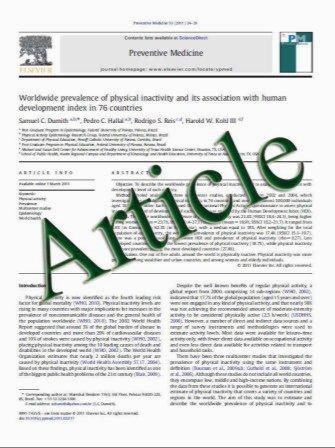Socioeconomic status and bone health in community-dwelling older men: the CHAMP Study
- نوع فایل : کتاب
- زبان : انگلیسی
- مؤلف : I. Nabipour & R. Cumming & D. J. Handelsman & M. Litchfield & V. Naganathan & L. Waite & H. Creasey & M. Janu & D. Le Couteur & P. N. Sambrook & M.
- چاپ و سال / کشور: 2010
Description
Summary The association between socioeconomic status (SES) and bone health, specifically in men, is unclear. Based upon data from the large prospective Concord Health in Ageing Men Project (CHAMP) Study of communitydwelling men aged 70 years or over, we found that specific sub-characteristics of SES, namely, marital status, living circumstances, and acculturation, reflected bone health in older Australian men. Introduction Previous studies reported conflicting results regarding the relationship between SES and bone health, specifically in men. The main objective of this study was to investigate associations of SES with bone health in communitydwelling men aged 70 years or over who participated in the baseline phase of the CHAMP Study in Sydney, Australia. Methods The Australian Socioeconomic Index 2006 (AUSEI06) based on the Australian and New Zealand Standard Classification of Occupations was used to determine SES in 1,705 men. Bone mineral density and bone mineral content (BMC) were determined by dualenergy X-ray absorptiometry. Bone-related biochemical and hormonal parameters, including markers of bone turnover, parathyroid hormone, and vitamin D, were measured in all men. Results General linear models adjusted for age, weight, height, and bone area revealed no significant differences across crude AUSEI06 score quintiles for BMC at any skeletal site or for any of the bone-related biochemical measures. However, multivariate regression models revealed that in Australian-born men, marital status was a predictor of higher lumbar BMC (β=0.07, p=0.002), higher total body BMC (β=0.05, p=0.03), and lower urinary NTX-I levels (β=−0.08, p=0.03), while living alone was associated with lower BMC at the lumbar spine (β=−0.05, p=0.04) and higher urinary NTX-I levels (β=0.07, p=0.04). Marital status was also a predictor of higher total body BMC (β= 0.14, p=0.003) in immigrants from Eastern and South Eastern Europe. However, in immigrants from Southern Europe, living alone and acculturation were predictors of higher femoral neck BMC (β=0.11, p=0.03) and lumbar spine BMC (β=0.10, p=0.008), respectively. Conclusions Although crude occupation-based SES scores were not significantly associated with bone health in older Australian men, specific sub-characteristics of SES, namely, marital status, living circumstances, and acculturation, were predictors of bone health in both Australia-born men and European immigrants.
Osteoporos Int (2011) 22:1343–1353 DOI 10.1007/s00198-010-1332-0 Received: 16 March 2010 / Accepted: 24 May 2010 / Published online: 23 June 2010


